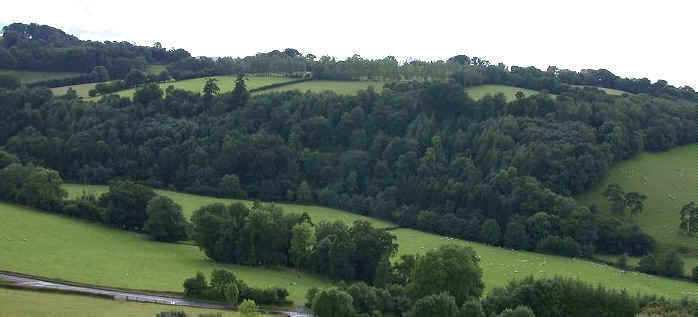
Types of Broadleaf
Woodland

In Britain, different types of woodland develop naturally as a result of local differences in geology, soil type, topography and climate. Historical land use and management will also affect the type of woodland which develops. Classifying these woodlands is a complex task. More than fifty different types of Broadleaf Woodland have been defined, utilizing both the trees and the underlying herbaceous vegetation to separate them out.
For the purposes of simplicity, this description includes only the main types likely to be encountered, as determined by the dominant tree species making up the wood. These include Oak, Beech, Ash, Birch and Alder/Willow Carr (wet woodland).
In
practice, woods rarely consist of pure stands of one species of tree (unless they have
been planted) and will usually contain mixtures of different species. This may include
mixes of broadleaf as well as coniferous trees together in the same wood. Many woods
consist of patchworks of different types as in the picture above.
| Different types of broadleaf tree are
usually fairly distinctive and relatively easy for the layman to identify. In addition,
different species will tend to cast different levels of shade. This in turn affects what
will grow underneath and hence the overall appearance of the wood. Broadleaf
woodlands are therefore most often separated on the basis of the dominant tree species
making up the woodland.
There are two native Oak species which commonly form woodland in Britain. Sessile Oak, Quercus petraea, has unstalked flowers and acorns, but stalked leaves. In contrast, Pedunculate Oak, Quercus robur, has the opposite characteristics with stalked flowers and acorns, but unstalked leaves. These two species can interbreed, forming intermediate forms which may be difficult to differentiate. Sessile Oak is the dominant Oak on the often shallow, acid soils of *Highland Britain, whereas Pedunculate Oak is more common on heavy clay soils in Lowland Britain. (Please note, these terms do not refer to altitudes, but instead reflect geological trends.) However, it is also common for the species to intermingle both with each other and with other tree species, to form mixed woods.
Oak woods are potentially some of the most diverse woods in Britain. Oak trees will support an enormous variety of invertebrate life (423 species). Of these, nearly 200 species are butterflies and moths. The rich bounty of caterpillars and other invertebrates attracts a wide variety of birds. Oaks are also an extremely long-lived species, with some recorded specimens being as much as 1000 years old. Such ancient trees have enormous biodiversity value because of the large number of microhabitats which they provide for species such as lichens (up to 324 species), as well as a great variety of invertebrates, birds and mammals. Of the two types, Pedunculate Oak woods are usually more diverse. They frequently have a very rich field layer, compared to the grassy, or heathy ground layer common in Sessile Oak woods. Sessile Oak woods often also have a poorly developed shrub layer, which particularly limits the bird life in the wood. Beech trees growing crowded together in a woodland, with their smooth grey trunks and dense, soaring light green canopies, can create an astonishingly cathedral-like impression. Where they are close together, the trees are forced to grow tall in the competition for light and will tend to have tall crowns and few lower branches. In their autumnal finery, beech woods glow with warm colour as the leaves turn spectacular shades of russet, gold and brown.
The distribution of Beech woods is much more restricted than that of Oak woods. It is a more recent UK species and is still expanding its range. Beech woods occur mainly on the chalk of the North and South Downs, the Chilterns, Dorset, Wiltshire, the Wye Valley and the Cotswolds. They tend to be concentrated on limestone soils although Beech is not restricted to this type of soil. Thus Beech trees are also found on acid sands and gravels. In some areas, Beech woods have historically been planted to supply local furniture industries. Beech woodlands are not as impoverished in terms of diversity as might be expected from the lack of underlying plant structure. The Beech trees themselves will support almost 100 different species of invertebrates and over 200 species of lichens. A number of fungi, for example, Porcelain Fungus, are also associated specifically with Beech woods. Where the trees are separated enough to allow light to reach the woodland floor, lower plant layers will also develop with a resultant increase in biodiversity. The harvest of Beech nuts, also known as Beech-mast, produced every autumn will also attract seasonal additions to the wildlife of the wood. Badgers, squirrels and a variety of birds, including Nuthatches, will all seek out the nutritious mast at this time.
|